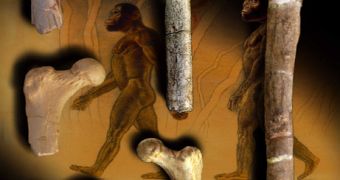Walking on two feet is one of the main traits of the human being. A new study published in the journal "Nature" shows that the six-million-year-old Kenyan hominin could have been the first species able to walk bipedally, based on bone anatomy.
"This provides really solid evidence that these fossils actually belong to an upright-walking early human ancestor," said lead author Brian Richmond, a biological anthropologist at George Washington University in Washington, D.C.
Several bones of Orrorin tugenensis were discovered in 2000 in northwest Kenya, coming from a critical period in the human evolution, as DNA analysis points that we split from chimps 4 to 8 million years ago.
To see if Orrorin was bipedal, the team analyzed the main indicators of bipedalism, like joint size and shaft strength of the femur bone, compared with other fossil hominins, living apes, and modern humans. The femur of Orrorin differed from that of modern humans and living apes, but closely resembled hominin fossils that had lived 2 to 3 million years ago.
"It really closely resembles the thighbone structure of early hominids like Australopithecus, the species that [the well-known female specimen] 'Lucy' belongs to," Richmond said.
Orrorin may have had a gait similar to Australopithecus and other hominins, a gait modernized when our genus, Homo, emerged about two million years ago.
"This suggests that you don't immediately become a modern, efficient biped all at once. As is so often the case in the evolution of any mammal, it happens in stages, and it's interesting to see the sequence of those events," said Donald Johanson, director of the Institute of Human Origins at Arizona State University and Lucy's finder.
The position of Orrorin in our lineage
The discoverers of Orrorin, Martin Pickford and Brigitte Senut of the Coll?ge de France, believe that the genus was in the direct lineage of the genus Homo, appeared two million years ago. In this case, all hominins found to have lived 6 million to 2 million years ago, the Australopithicines, were not our ancestors, but an extinct branch in the human evolution. The new study challenges this concept.
"Our analysis shows that these fossils resemble early hominin fossils more than they resemble Homo at two million years ago. It is likely to be ancestral to these early forms, not requiring a ghost lineage that goes undiscovered for four million years [until Homo's appearance]," said Richmond.
Some believe Orrorin resembles older hominids and was actually a tree-dweller.
"It does not make sense [to] interpret the anatomical features of O. tugenensis as a biped that could climb trees. I see it as a good arboreal quadruped that has a package of features like [those found in] Australopithecus," said Terry Harrison, a biological anthropologist of the Center for the Study of Human Origins at New York University, who studies hominins older than Orrorin.
But Richmond signals that all early human ancestors, like Australopithecines, were bipedal when on the ground, but could climb trees very well too.
"The upper limb looks very much like a chimp's does today. That points to the idea that O. tugenensis still had a powerful upper limb used in climbing trees. It probably did that regularly to access food, to sleep at night, or to escape predators," said Richmond.

 14 DAY TRIAL //
14 DAY TRIAL //